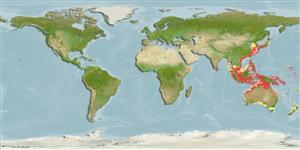Environment: milieu / climate zone / depth range / distribution range
Écologie
marin récifal; profondeur ? - 100 m (Ref. 90102). Tropical
Indo-West Pacific: India east to Indochina, then north to Japan and China to the Philippines, Indonesia and Australia.
Taille / Poids / Âge
Maturity: Lm ? range ? - ? cm
Max length : 29.5 cm TL mâle / non sexé; (Ref. 126280); poids max. publié: 453.00 g (Ref. 126280)
Épines dorsales (Total): 4 - 5; Rayons mous dorsaux (Total): 13-14; Épines anales 13. Indonesian form has pale body with dark blotches (Ref. 48636). Body dark brown with 3 distinct broad black bands. Respiratory valve inside lower jaw with a thick orange tentacle (Ref 42788).
Found above 100 m on sandy gravel bottom (Ref. 11230). Lives on muddy substrates and rarely observed (Ref. 48636). Hides in sandy bottoms and sucks up animals with sand and debris into the mouth.
Life cycle and mating behavior
Maturité | Reproduction | Frai | Œufs | Fécondité | Larves
Masuda, H., K. Amaoka, C. Araga, T. Uyeno and T. Yoshino, 1984. The fishes of the Japanese Archipelago. Vol. 1. Tokai University Press, Tokyo, Japan. 437 p. (text). (Ref. 559)
Statut dans la liste rouge de l'IUCN (Ref. 130435)
Menace pour l'homme
Harmless
Utilisations par l'homme
Pêcheries: intérêt commercial mineur; Aquarium: Commercial
Plus d'informations
Noms communsSynonymesMétabolismePrédateursÉcotoxicologieReproductionMaturitéFraiRassemblement de ponteFéconditéŒufsDéveloppement de l'œuf
RéférencesAquacultureProfil d'aquacultureSouchesGénétiqueElectrophoresesHéritabilitéPathologiesTraitementNutrientsMass conversion
CollaborateursImagesStamps, Coins Misc.SonsCiguateraVitesseType de nageSurface branchialeOtolithesCerveauxVision
Outils
Articles particuliers
Télécharger en XML
Sources Internet
Estimates based on models
Preferred temperature (Ref.
123201): 22.9 - 29, mean 28 °C (based on 1308 cells).
Phylogenetic diversity index (Ref.
82804): PD
50 = 0.5000 [Uniqueness, from 0.5 = low to 2.0 = high].
Bayesian length-weight: a=0.01072 (0.00554 - 0.02071), b=3.09 (2.92 - 3.26), in cm total length, based on LWR estimates for this species & Genus-body shape (Ref.
93245).
Niveau trophique (Ref.
69278): 4.1 ±0.7 se; based on size and trophs of closest relatives
Résilience (Ref.
120179): Milieu, temps minimum de doublement de population : 1,4 à 4,4 années (Preliminary K or Fecundity.).
Fishing Vulnerability (Ref.
59153): Low vulnerability (20 of 100).
